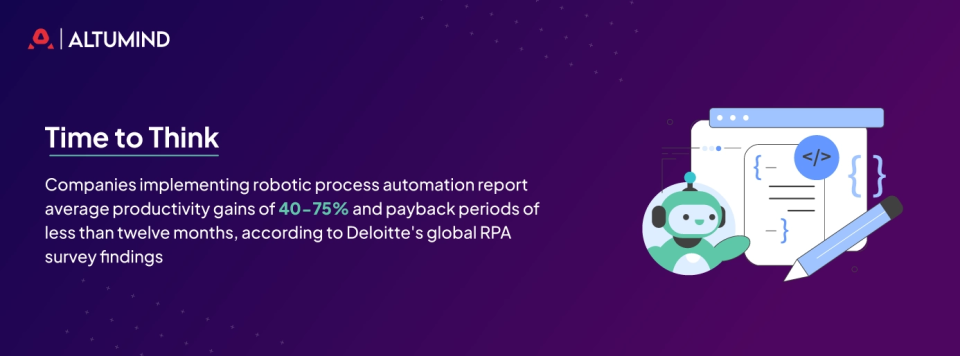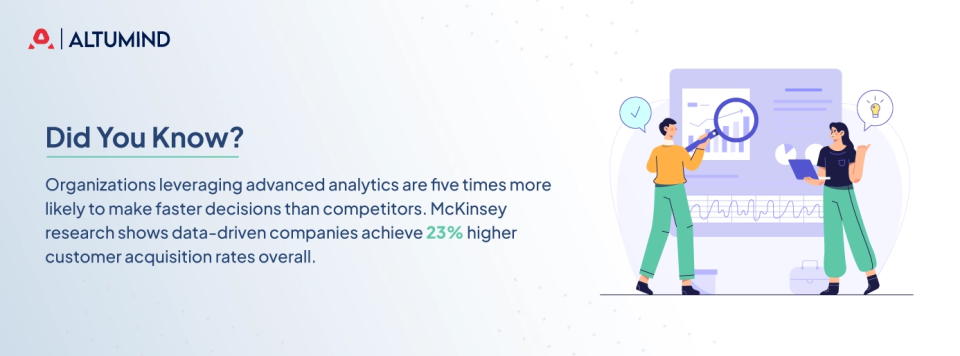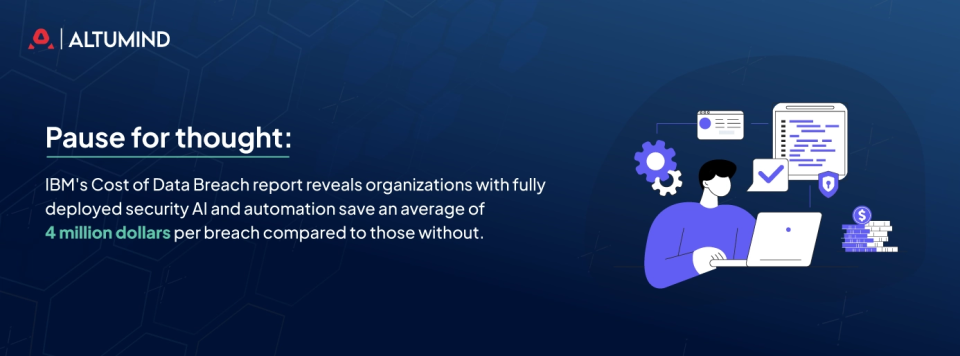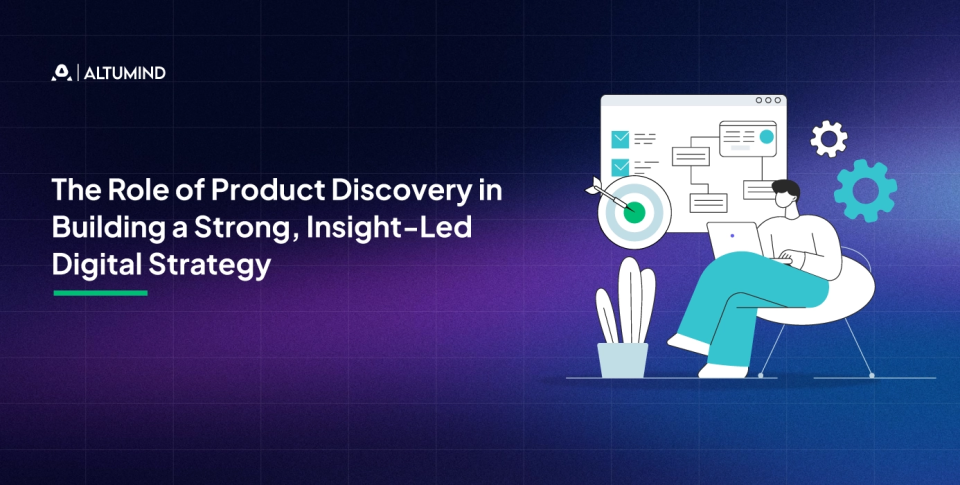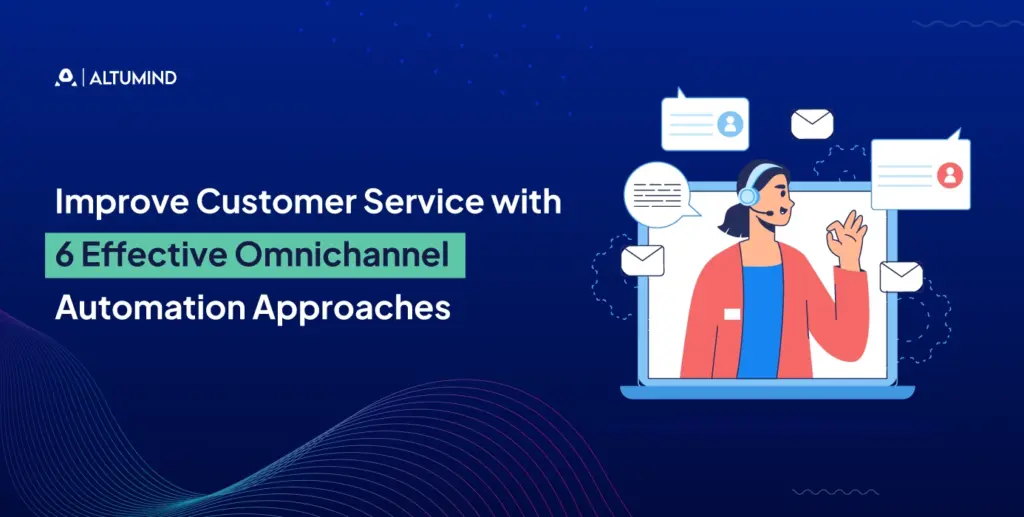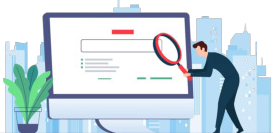How Enterprise IT Solutions Are Driving Digital Transformation Success in 2025
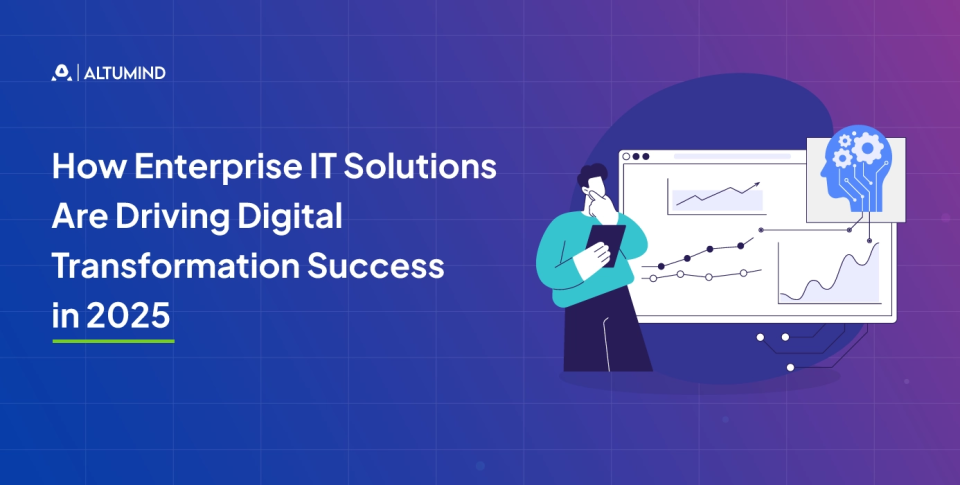
Organizations face unprecedented challenges in managing complex IT infrastructure while staying competitive. Digital transformation requires more than basic technology upgrades; it demands comprehensive enterprise IT solutions that integrate systems seamlessly.
Modern enterprises generate massive amounts of data across multiple platforms and applications. Teams struggle to access information quickly, leading to productivity losses and missed opportunities.
The stakes are high:
- Companies lose an average of $5,600 per minute during system downtime.
- Security breaches result in millions in damages and regulatory fines.
- Legacy systems create bottlenecks that prevent scaling.
- Fragmented technology landscapes hinder collaboration.
Forward-thinking organizations partner with providers who deliver integrated solutions. These comprehensive approaches transform disconnected systems into unified digital ecosystems.
This guide explores how enterprise IT solutions enable successful digital transformation. Discover proven strategies for cloud migration, data-driven decision-making, and security enhancement. Learn how Altumind helps businesses achieve extraordinary results.
What Are Enterprise IT Solutions?
Enterprise IT solutions encompass comprehensive services that manage and optimize organizational technology infrastructure. These solutions address every aspect of IT operations.
Core Components Include:
Network Infrastructure
- Reliable connectivity for applications and data sharing
- Continuous monitoring for optimal performance
- Security measures to protect against threats
- Scalable architecture that grows with business needs
Cloud Platforms
- Reduced capital expenses through pay-as-you-go models.
- Improved scalability without hardware investments.
- Multi-cloud strategies for flexibility.
- Disaster recovery and business continuity.
Data Management
- Secure storage and backup systems.
- Analytics capabilities for business insights.
- Governance frameworks for compliance.
- Real-time access to critical information.
Application Systems
- Custom development for unique business needs.
- Legacy modernization for outdated systems.
- Integration services connecting multiple platforms.
- Regular updates and performance optimization.
Why Does Digital Transformation Matter?
Digital transformation represents fundamental changes in how organizations operate and deliver value. Technology becomes a strategic enabler rather than just operational support.
Key Drivers
| Driver | Key Points |
|---|---|
| Customer Expectations |
|
| Competitive Pressure |
|
| Operational Efficiency |
|
Altumind's Enterprise IT Services
Altumind delivers future-ready enterprise IT solutions by integrating systems, automation, cloud, and data. The company transforms fragmented digital strategies into powerful unified ecosystems.
1. Cloud Migration & Management
Assessment Phase:
- Evaluate which workloads benefit from cloud migration.
- Analyze application dependencies and data requirements.
- Review compliance needs and regulatory constraints.
- Choose optimal migration strategies for each system.
Migration Execution:
- Follow detailed plans that minimize business disruption.
- Handle data transfer with zero data loss.
- Reconfigure applications for cloud environments.
- Conduct thorough testing before cutover.
Ongoing Optimization:
- Right-size resources to balance performance and costs.
- Monitor utilization patterns continuously.
- Implement auto-scaling for variable workloads.
- Generate regular performance and cost reports.
Management Services:
- 24/7 monitoring of cloud infrastructure
- Automated backup and disaster recovery
- Security patch management
- Compliance tracking and reporting
2. AI & Machine Learning Solutions
Artificial intelligence and machine learning unlock deep business insights from data. Altumind specializes in multiple AI platforms for enterprise applications.
Key Capabilities:
Intelligent Document Processing
- Extract data from invoices, contracts, and forms automatically
- Reduce manual data entry by 80-90%
- Improve accuracy through machine learning
- Process thousands of documents daily
Predictive Analytics
- Forecast customer behavior and demand patterns.
- Anticipate equipment failures before they occur.
- Identify trends in business metrics.
- Enable proactive rather than reactive management.
Process Automation
- Handle repetitive business tasks automatically.
- Make routine decisions based on defined rules.
- Escalate exceptions to human specialists.
- Free employees for higher-value work.
Natural Language Processing
- Deploy chatbots for customer service
- Automate email classification and routing
- Analyze customer feedback at scale
- Enable voice-activated systems
3. Data Analytics & Business Intelligence
Data-driven decision-making separates industry leaders from followers. Altumind transforms raw data into actionable insights.
Services Include:
Data Integration
- Consolidate information from multiple sources
- Connect transactional systems and databases
- Include external data for market insights
- Create unified views of business operations
Visualization & Dashboards
- Present complex data through intuitive interfaces
- Enable self-service analytics for business users
- Provide real-time monitoring of key metrics
- Support mobile access for executives
Advanced Analytics
- Apply statistical methods to uncover patterns
- Identify correlations and anomalies
- Segment customers for targeted marketing
- Optimize pricing and inventory strategies
Real-Time Analytics
- Monitor operations as they happen
- Alert stakeholders to critical events
- Enable immediate response to issues
- Track campaign performance live
4. Application Development & Modernization
Custom applications address unique business requirements that off-the-shelf software cannot meet.
Development Services:
Custom Application Development
- Build solutions tailored to specific needs.
- Use modern frameworks and technologies.
- Ensure scalability and performance.
- Integrate with existing systems seamlessly.
Legacy Modernization
- Transform outdated systems into modern platforms.
- Preserve business logic while updating technology.
- Improve user interfaces and experiences.
- Reduce maintenance costs significantly.
Cloud-Native Development
- Build applications optimized for the cloud.
- Leverage microservices architecture.
- Enable continuous deployment.
- Scale automatically based on demand.
API & Integration Services
- Connect applications for unified workflows.
- Enable secure data exchange.
- Build reusable integration components.
- Support real-time synchronization.
5. Managed IT Services
Ongoing technology management ensures systems perform reliably and securely. Altumind provides comprehensive managed IT services.
Service Components:
Proactive Monitoring
- Track performance metrics 24/7.
- Detects issues before users notice.
- Monitor security events continuously.
- Alert administrators to anomalies.
Help Desk Support
- Provide responsive user assistance.
- Resolve issues quickly to minimize disruption.
- Offer self-service knowledge bases.
- Track satisfaction metrics.
Security Management
- Implement enterprise IT security solutions.
- Deploy firewalls and intrusion detection.
- Manage encryption and access controls.
- Conduct regular vulnerability assessments.
Patch Management
- Keep systems updated with security fixes.
- Test patches before deployment.
- Automate update processes.
- Maintain compliance with standards.
Key Benefits of Enterprise IT Solutions
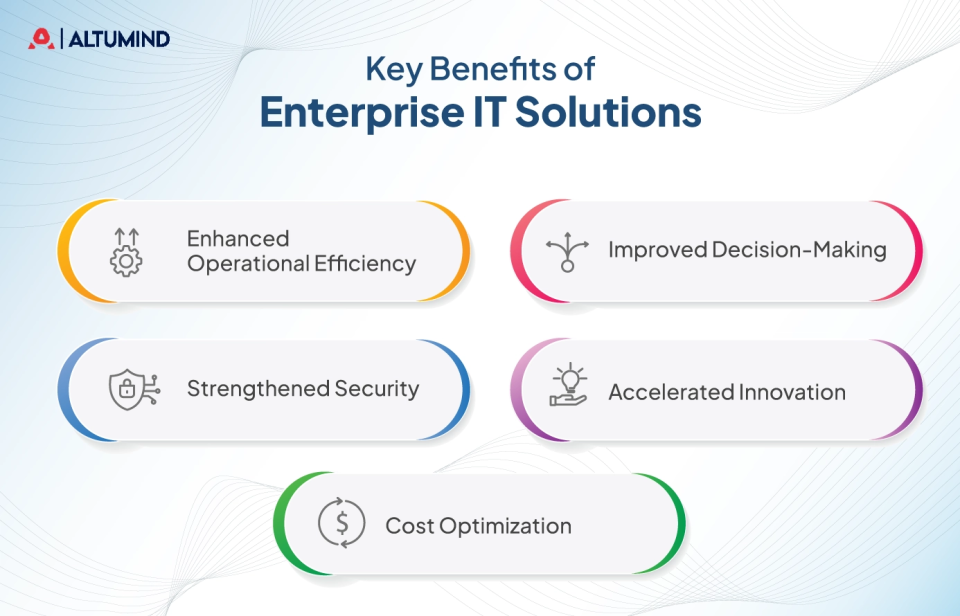
Organizations implementing modern enterprise IT solutions experience measurable improvements. These benefits impact both operations and business outcomes.
1. Enhanced Operational Efficiency
Automation Advantages:
- Eliminate repetitive manual tasks.
- Reduce human error rates by 70-80%.
- Process transactions faster.
- Scale operations without adding staff.
System Integration:
- Remove duplicate data entry.
- Enable automatic information flow.
- Accelerate business processes.
- Improve data accuracy.
2. Improved Decision-Making
Real-Time Data Access:
- Make decisions based on current information.
- Respond quickly to changing conditions.
- Monitor operations continuously.
- Track KPIs in real-time.
Advanced Analytics:
- Uncover hidden patterns in data.
- Understand customer behavior deeply.
- Identify market opportunities.
- Predict future trends accurately.
3. Strengthened Security
Multi-Layered Protection:
- Implement defense-in-depth strategies.
- Address multiple threat vectors.
- Protect sensitive business data.
Continuous Monitoring:
- Detects threats in real time.
- Identify suspicious activities immediately
- Respond to incidents within minutes.
- Minimize potential damage.
4. Accelerated Innovation
Faster Development:
- Launch products and features quickly.
- Iterate based on user feedback.
- Deploy updates without downtime.
- Stay ahead of competitors.
Cloud Advantages:
- Access development resources instantly.
- Eliminate procurement delays.
- Experiment without large investments.
- Scale innovations rapidly.
5. Cost Optimization
Reduced Capital Expenses:
- Transform CapEx into OpEx.
- Avoid large upfront investments.
- Improve financial flexibility.
- Optimize cash flow.
Labor Efficiency:
- Accomplish more with existing teams.
- Reduce overtime requirements.
- Lower training costs.
- Minimize recruitment needs.
Implementation: Step-by-Step Guide
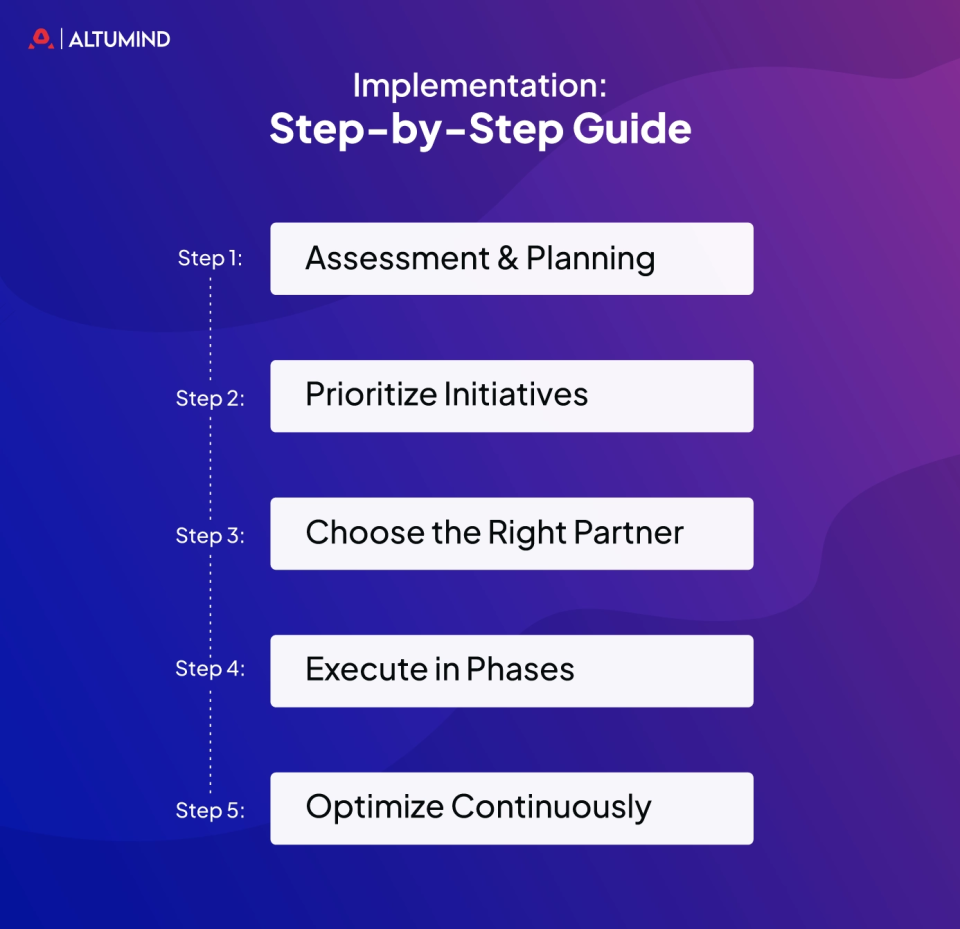
Successful enterprise IT solutions implementation requires careful planning and execution. Follow these proven steps to ensure optimal results and maximize return on investment while minimizing risks throughout the transformation journey.
Step 1: Assessment & Planning
Begin your transformation journey with a thorough evaluation of your current state. Understanding existing capabilities, identifying gaps, and engaging key stakeholders creates a solid foundation for successful implementation and ensures alignment with organizational objectives.
- Conduct a comprehensive assessment of the current IT infrastructure, applications, and processes to identify strengths and weaknesses.
- Engage stakeholders across all business units to gather requirements and secure executive sponsorship.
- Document existing systems, technology architecture, and integration points for complete visibility.
- Analyze organizational technology skills, team capabilities, and readiness for change initiatives.
- Define future state architecture vision with realistic goals, success metrics, and a phased roadmap.
Step 2: Prioritize Initiatives
Strategic prioritization ensures resources focus on high-impact opportunities. Evaluate initiatives based on business value, complexity, and alignment with goals. Quick wins demonstrate value early, building momentum and confidence for larger transformation efforts ahead.
- Evaluate each initiative based on business impact potential and strategic alignment with organizational objectives.
- Assess implementation complexity, required resources, and technical dependencies for realistic planning.
- Focus on quick wins that demonstrate tangible value and build stakeholder confidence early.
- Generate transformation momentum through early successes that secure additional resources and support.
- Balance short-term achievements with long-term strategic goals for sustainable transformation progress.
Step 3: Choose the Right Partner
Selecting the right implementation partner significantly impacts transformation success. Evaluate partners on industry experience, technical capabilities, cultural fit, and proven track record. The right partner brings expertise, methodology, and commitment to your goals.
- Evaluate partners based on industry-specific experience and a deep understanding of your business challenges.
- Assess technical capabilities, certifications, and expertise across relevant technology platforms and solutions.
- Determine cultural fit and alignment with your organization’s values, work style, and expectations.
- Review proven track record through case studies, references, and demonstrated success stories.
- Partner with organizations like Altumind, offering an integrated transformation approach and long-term commitment.
Step 4: Execute in Phases
Phased execution reduces risk and enables continuous learning. Start with pilot programs in controlled environments, gather intensive feedback, and refine approaches before broader rollout. Incorporate change management throughout to ensure user adoption and success.
- Launch pilot programs with a limited scope to test solutions in controlled environments.
- Implement iterative development cycles, releasing functionality incrementally with regular progress demonstrations.
- Establish robust change management processes, communicating benefits, providing training, and supporting users.
- Gather feedback intensively during pilots and refine solutions before broader organizational rollout.
- Address user concerns proactively while incorporating learnings to adjust implementation approaches continuously.
Step 5: Optimize Continuously
Transformation doesn’t end at deployment. Continuous optimization through performance monitoring, feedback gathering, and strategic technology updates maintains competitive advantages. Build a culture of improvement that responds to user needs and evolving business requirements.
- Monitor key performance metrics, daily tracking system performance, user satisfaction, and business outcomes.
- Establish multiple feedback channels, encouraging user suggestions and building trust through responsive improvements.
- Analyze collected data to identify optimization opportunities and measure return on investment.
- Evaluate new technologies regularly and adopt innovations strategically that align with business goals.
- Update systems and processes based on learnings while maintaining stability and competitive advantages.
Enterprise IT Security Best Practices
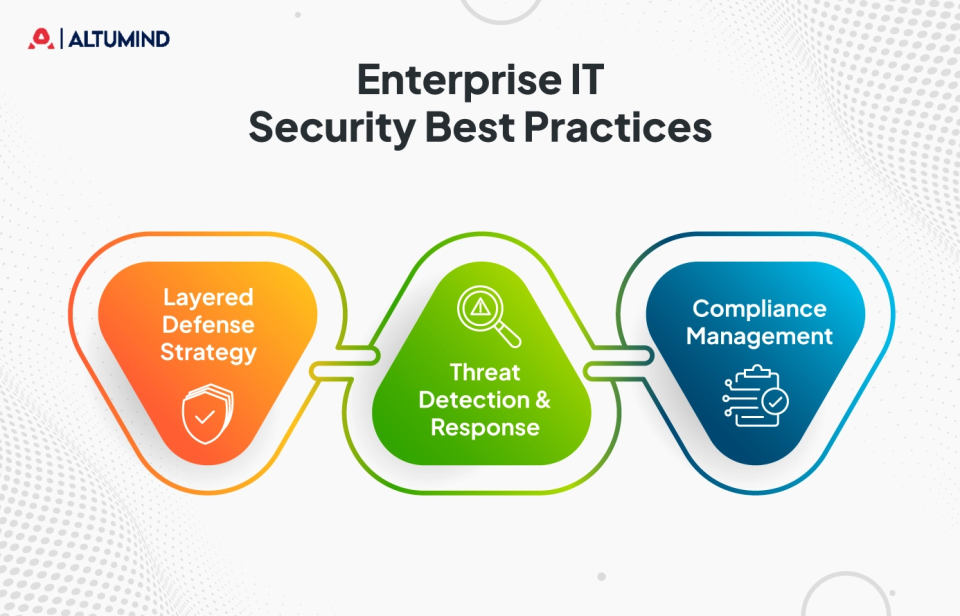
Enterprise IT security solutions protect organizations from growing cyber threats. Implement these essential practices.
1. Layered Defense Strategy
Perimeter Security:
- Deploy next-generation firewalls.
- Filter traffic based on policies.
- Block malicious IP addresses.
Inspect encrypted traffic.
Identity Management:
- Require multi-factor authentication.
- Implement single sign-on.
- Use role-based access controls.
- Review permissions regularly.
Data Protection:
- Encrypt sensitive information.
- Secure data in transit.
- Protect data at rest.
- Manage encryption keys properly.
Application Security:
- Follow secure coding practices.
- Test for vulnerabilities regularly.
- Patch security flaws quickly.
- Monitor application behavior.
2. Threat Detection & Response
Advanced Monitoring:
- Use behavioral analytics.
- Correlate events from multiple sources.
- Apply machine learning for detection.
- Identify zero-day threats.
Incident Response:
- Define clear procedures.
- Establish communication protocols.
- Conduct regular drills.
- Review and improve processes.
Automated Actions:
- Lock compromised accounts immediately.
- Block suspicious traffic automatically.
- Isolate infected systems quickly.
- Collect forensic evidence.
3. Compliance Management
Regulatory Requirements:
- GDPR for data privacy.
- HIPAA for healthcare information.
- PCI DSS for payment data.
- SOC 2 for service organizations.
Best Practices:
- Document policies clearly.
- Train employees regularly.
- Conduct internal audits.
- Maintain compliance evidence.
Measuring Success & ROI
Track these metrics to evaluate enterprise IT solutions effectiveness.
1. Cost Reduction Metrics
Infrastructure Savings:
- Compare cloud costs to on-premises.
- Calculate capital expense avoidance.
- Measure operational cost reductions.
- Track energy and facility savings.
Labor Efficiency:
- Quantify hours saved through automation.
- Calculate reduced overtime costs.
- Measure support ticket reductions.
- Assess training cost decreases.
Downtime Prevention:
- Value avoided outage costs.
- Calculate productivity preservation.
- Measure revenue protection.
- Assess reputation impact avoidance.
2. Productivity Improvements
Time-to-Market:
- Track product launch acceleration.
- Measure feature delivery speed.
- Calculate competitive advantage value.
- Assess market opportunity capture.
Employee Efficiency:
- Survey time saved on tasks.
- Measure process cycle time reduction.
- Calculate capacity freed for innovation.
- Assess quality improvements.
Decision Speed:
- Track planning cycle acceleration.
- Measure response time improvements.
- Calculate agility benefits.
- Assess opportunity capture rates.
3. Business Outcomes
Revenue Growth:
- Attribute sales to new capabilities.
- Measure market expansion enabled.
- Calculate customer acquisition improvements.
- Assess upsell and cross-sell increases.
Customer Satisfaction:
- Track NPS score improvements.
- Measure retention rate increases.
- Calculate lifetime value growth.
- Assess referral rate improvements.
Market Position:
- Monitor market share changes.
- Track competitive win rates.
- Measure brand perception improvements.
- Assess innovation leadership recognition.
Why Partner with Altumind?
Altumind stands out as a leading provider of enterprise IT solutions and digital transformation services.
Proven Expertise
Technical Capabilities:
- Cloud platforms: AWS, Azure, and Google Cloud.
- AI/ML: TensorFlow, PyTorch, scikit-learn.
- Analytics: Tableau, Power BI, custom solutions.
- Development: Full-stack, mobile, cloud-native.
Industry Experience:
- Retail and e-commerce.
- Financial services.
- Healthcare and life sciences.
- Manufacturing and logistics.
Certifications & Partnerships:
- Major cloud provider partnerships.
- Industry-recognized certifications.
- Security compliance attestations.
- Technology vendor relationships.
Integrated Approach
Comprehensive Solutions:
- Address technology, process, and people.
- Integrate multiple capabilities seamlessly.
- Align with business objectives.
- Deliver unified digital ecosystems.
End-to-End Services:
- Strategy and planning.
- Design and development.
- Implementation and migration.
- Support and optimization.
Client-Centric Focus
Partnership Philosophy:
- Align success metrics with client outcomes.
- Work collaboratively with internal teams.
- Transfer knowledge continuously.
- Build long-term relationships.
Proven Track Record:
- Successful projects across industries.
- Measurable business results.
- High client satisfaction scores.
- Strong referral rates.
Conclusion
Modern business success demands sophisticated enterprise IT solutions that integrate technology seamlessly. Organizations cannot compete with fragmented systems and manual processes. Comprehensive approaches addressing cloud infrastructure, data analytics, automation, and security are essential for scalability, informed decision-making, and cost efficiency.
Altumind delivers integrated solutions spanning cloud migration, AI/ML, data analytics, and application development. Their proven methodologies, expert guidance, and collaborative approaches ensure successful implementations while building internal capabilities, delivering measurable business value, and maintaining long-term competitive advantages.
Table of Contents
Let's Connect
Reach out and explore how we can co-create your digital future!

